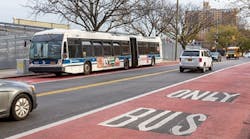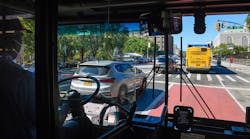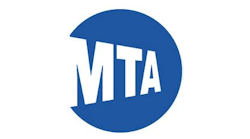MTA activates ABLE cameras on Bx36 bus route
The Metropolitan Transportation Authority (MTA) has activated automated bus lane enforcement (ABLE) cameras on the Bx36 bus route in the Bronx. ABLE cameras capture drivers violating busway and bus lane rules in real-time. The implementation of these cameras is aimed at deterring motorists from blocking bus lanes, to improve bus service and reduce crashes. Average daily ridership on the Bx36 is 30,700, with average speeds of 6.3 mph.
Upon implementation of ABLE cameras, the New York City Department of Transportation (NYCDOT) will issue warning notices to motorists for the first 60 days, in accordance with state law, to ensure drivers are informed about the program before any fines are levied. Each bus lane corridor with ABLE camera coverage has signage indicating the hours the bus lanes are operable and advises drivers that the lanes are camera-enforced.
“Customers tell us in survey after survey that raising bus speeds and shortening travel time will increase their satisfaction and encourage them to ride more often, and we have seen how effective ABLE cameras are on the existing bus lanes,” said New York City Transit (NYC Transit) President Richard Davey. “By activating ABLE cameras on the Bx36 bus route, over 30,000 daily customers will benefit from faster and safer trips.”
“Automated camera enforcement is a crucial part of speeding up buses and allowing riders to get to school, work, appointments and everything else the city has to offer,” said NYC Transit Department of Buses Senior Vice President Frank Annicaro. “These onboard cameras enable the MTA to enforce our bus lanes and is a proven and effective tool to increase compliance with the bus lanes.”
In addition to ABLE cameras, the MTA and NYCDOT kicked off the Tremont Av Bus Priority Improvement project in December, with the goal of increasing sustainable travel and expanding access to job opportunities through faster and more reliable transportation options. The study will evaluate priority treatments between Sedgwick Avenue and Boston Road, building upon the success of ABLE and further improving bus service for Bx36 riders who face slow and unreliable commutes due to congestion and double parking.
With the activation on this route, the MTA will have 503 buses equipped with ABLE cameras on 18 routes across Brooklyn, Manhattan, the Bronx, Staten Island and Queens. Locations were determined to maximize the length of bus lanes covered, balance distribution between boroughs, address some of the newer bus lanes and incorporate input from the MTA and NYCDOT on known locations with issues.
In October 2022, the MTA announced it would equip 300 additional buses with ABLE cameras across nine routes by the end of 2022. That installation brought ABLE cameras for the first time to Queens, with the Q44 and Staten Island, with the S79 and the Bronx, with the Bx12 and Bx41.
ABLE camera systems capture license plate information, photos and videos, together with location and timestamp information. This information is then transmitted to NYCDOT for review and processing. The program is administered in partnership with NYCDOT and the New York City Department of Finance.
"As my constituents rely heavily on buses, the activation of ABLE cameras is a great addition that will keep drivers and bus riders safe,” said New York State Assembly Member Kenny Burgos. “I thank the MTA and NYCDOT for bringing this technology to the Bronx, and I look forward to seeing the success it will have in the borough.”
“Today’s announcement on the expansion of ABLE cameras to include the Bx36 route comes as great news and demonstrates the MTA’s ongoing commitment to serving Bronx commuters who rely on New York City Transit to get to and from their destinations safely and efficiently,” said Bronx Borough President Vanessa Gibson. “Already implemented on bus routes like the Bx12, Bx41 and others, ABLE has increased the speed and on-time performance of buses throughout New York City by keeping bus lanes clear of vehicles. I want to thank MTA Chair and CEO Janno Lieber and his entire team for prioritizing the needs of Bronx riders. I look forward to working collaboratively to identify future routes that would benefit as well.”




